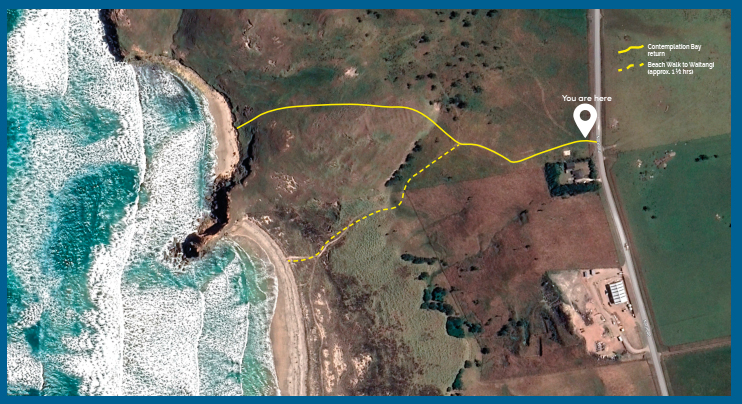There is nowhere else quite like it. Nestled between two headlands of limestone and only 300 metres long, ‘Contemplation Bay’ (named by Toni Croon) is aptly named. It is an awe-inspiring spot to behold and observe the full power of the sea.
Why here? Because it faces southwest and takes the full brunt of the prevailing SW weather.
It is one of the steepest and most dangerous beaches in the Chathams. Not to be trifled with, but stunning to contemplate and marvel at, especially in a SW storm.

Geologists:
Contemplation Bay is of particular interest to geologists because it is at the southern end of Red Bluff, part of the one and only substantial bit of limestone coast on Chatham Island that faces the ocean.
The beach also sports unusual creamy white boulders of relatively hard limestone, and they are not seen anywhere else in the Chathams. Rolled into shape and washed clean by the waves, they reveal their biogenic origin in full glory. The limestone is made up almost entirely by the fossil skeletal calcite remains of shelly marine organisms, mainly bryozoans (moss animals), foraminifera (plankton) and echinoderms (kina). White fossil kina or sea-urchin spines are especially abundant and conspicuous.
The limestone is the Te Whanga Limestone Formation and it is of Eocene age, between 55 and 35 million years old. It is much older than the widespread limestone formations in mainland New Zealand which are mainly of Oligocene and Miocene age, between 30 and 20 million years old.
Views:
The views from the high points above Contemplation Bay are magnificent. You can see the full extent of the beach and its marram-clothed sand dunes stretching in a long smooth curve south all the way to Waitangi. And the huge westward gaping extent of Petre Bay can be taken in from Point Durham 16 km to the SW, to the distant volcanic cone of Matakitaki 25 km away to the NW. Petre Bay is box-shaped, the product of erosion from the constant hammering by the SW weather. Needless to say, the geology has a lot to answer for: easily eroded softer weaker and younger sedimentary rocks dominate central Chatham Island and they are sandwiched between older hard basalt rocks to the south and the even older hard schist rocks to the north.
You can also see the full extent of the southern Chatham ‘massif’, stretching from near Owenga in the far SE, to Point Durham in the SW. It is remarkably flat in profile from this vantage point and is less than 300 metres in height. It is the erosional remnant of the northern flank of a large basalt shield volcano (Chatham Volcano) some 25 to 30 kilometres in radius, that was centred in Pitt Strait. It erupted on land in Late Cretaceous time, 85 to 80 million years ago, producing many basalt lava flows (Southern Volcanics Formation). The white building of Kopinga Marae is conspicuous and provides a useful measure of height, located about 100 metres above sea level.
 Tikitiki Hill and the conspicuous red cliffs behind Waitangi are the remnants of a submarine basalt volcano that erupted on the sea floor 60 to 50 million years ago. Red Bluff, conspicuous from all around Petre Bay, is another submarine volcano and is of similar age (55 to 50 million years old) but differs from Tikitiki Hill in having a substantial younger drape of limestone all over it. The red colour is due to iron oxide and hydroxide minerals (natural rust) within the rock which is known to geologists as the Red Bluff Tuff Formation. ‘Tuff’ is a rock form of volcanic ash or tephra. Interestingly, the dominant minerals that make up the Red Bluff Tuff are clay minerals and clay is surprisingly difficult to erode, so Red Bluff Tuff forms positive upstanding relief in the landscape. Most of the hills and high ground in the Chathams are sculptured from Red Bluff Tuff.
Tikitiki Hill and the conspicuous red cliffs behind Waitangi are the remnants of a submarine basalt volcano that erupted on the sea floor 60 to 50 million years ago. Red Bluff, conspicuous from all around Petre Bay, is another submarine volcano and is of similar age (55 to 50 million years old) but differs from Tikitiki Hill in having a substantial younger drape of limestone all over it. The red colour is due to iron oxide and hydroxide minerals (natural rust) within the rock which is known to geologists as the Red Bluff Tuff Formation. ‘Tuff’ is a rock form of volcanic ash or tephra. Interestingly, the dominant minerals that make up the Red Bluff Tuff are clay minerals and clay is surprisingly difficult to erode, so Red Bluff Tuff forms positive upstanding relief in the landscape. Most of the hills and high ground in the Chathams are sculptured from Red Bluff Tuff.
